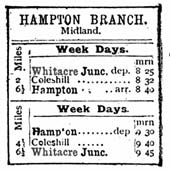 |
|
London North Western
Railway:

Midland
Railway:

Stratford
Midland Junction Railway
|

|
LMS Route: Hampton in Arden to Whitacre
As early as 1824, Birmingham businessmen had been looking at
the possibilities of the railway. The London and Birmingham Railway and the
Grand Junction Railway had obtained their Acts of Parliament in 1833 and scheme
for a line to Gloucester and Bristol was in the air.. The North Midland had
been floated in 1833 and a proposal was made to connect to its terminus at
Derby. George Stephenson surveyed the route in 1835 bill envisaged the line as
running through Whitacre to meet the London and Birmingham Railway with a
junction at Stechford to travel into the latter's terminus at Curzon Street. It
would also run from Whitacre to Hampton-in-Arden, where it would join the
L&B for connections to London.
The promoters came into conflict with those of the Midland
Counties Railway even before the bills were presented to Parliament since the
lines would compete with each other. In the end, the Birmingham and Derby line
agreed to withdraw their branch to Hampton if it the Midland Counties withdrew
their line along the Erewash valley. With the active support of Prime Minister
Robert Peel, the member for Tamworth, the Birmingham and Derby Junction Railway
Bill passed through Parliament on 19 May 1836, The Hampton branch had been
removed, but when the Midland Counties presented their bill, it still contained
the Erewash line (although it was later dropped on the insistence of the North
Midland Railway). The Birmingham and Derby people therefore presented a fresh
bill in 1840 for the branch as a separate line which later became known as the
'Stonebridge Railway'.
The Stonebridge Railway was opened in 1839 in Warwickshire,
England as part of the main Birmingham and Derby Junction Railway. The line ran
from Whitacre Junction to Hampton and had an intermediate station at Coleshill
(re-named Maxstoke in 1923). From 1839 until 1840 it was a double track main
line, linking in with the London and Birmingham Railway at 'Derby Junction',
Hampton, the remains of which can still be seen north of the current LNWR
station named by the latter as 'Hampton-in-Arden' to avoid confusion between
the Midland Railway's station. The line was originally built with double track
when first opened on 5th August 1839 reflecting its importance to the B&DJR
as its gateway to London via the L&BR. The line reverted to single track
between August 1842 and March 1843 when its importance as a route to and from
the North on MR metals was significantly down graded by the opening on the 1st
July 1840 of the Leicester to Rugby route and on the 10th February 1842 the
Whitacre to Birmingham line.
The number of passenger services never again reached the
anticipated volume and because the line was not now fully utilised the line was
singled between August 1842 and March 1843. Even after the line was singled, of
the three daily services each way, two carried through coaches to London until
February 1845. The daily service of three trains each way was reduced to two in
1859, and from May 1877 the service was reduced to a single coach morning train
in each direction. This being the minimum level of service required by
Parliament. The line lost its final passenger service in 1917 as a wartime
economy measure. The line was closed in 1935 following a bridge failure in
Packington, however most of the line was used for the storage of disabled
wagons until the 1950s, when the track was finally removed. Two of the most
famous men in Midland Railway history were associated with this line - Sir
James Joseph Allport who became General Manager, and Matthew Kirtley who was
Locomotive Superintendent and both initially lived adjacent to Hampton
station.
The week day service of train per day had the train
departing Whitacre Junction at 8:25 am, Coleshill/Maxstoke at 8:32 am to arrive
at Hampton at 8:40 am. The return service was as follows: departs Hampton at
9:30 am, Coleshill/Maxstoke at 9:40 am and arriving to Whitacre Junction at
9:45 am.

Popular
Mechanics claimed the Hampton to Whitacre Junction timetable was 'about the
size of a postage stamp' |
|
News of the down grading reached even the USA with
the following short article appearing in the December 1907 edition of 'Popular
Mechanics'.
ENGLISH RAILROAD OF ''ONES'
One Engine, One
Coach, One Conductor, One Everything
Another "one" railroad we have right here at home and
in one respect beats the English road. One The branch of the Midland Railroad
running between Whitacre Junction and Hampton-in-Arden, appropriately known as
"The Line of Ones," is one of the most extraordinary railways in the world. It
possesses only one engine, one coach, or carriage as it is called in England,
and one The Time Table track. There is only one train a day and one
intermediate station. Each grade of the stall' has but one member, and one of
these takes the dual part of station-master and signalman. The time table is
about the size of a postage stamp.
of the largest railroad systems in the United States
has a small branch connecting St. Clair, Mich., with Memphis, 16 miles distant.
This branch has all the "ones" the English road can boast of and one more: The
one engineer has only one arm. |
Midland Railway 1853 Working Timetables: Whitacre Junction
to Hamption (Derby Junction) and Hampton (Derby Junction) to Whitacre
Junction

|
